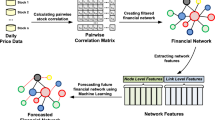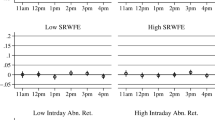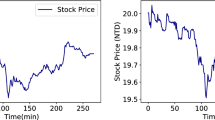Abstract
This paper presents the computational results obtained in strategy experiments in an artificial futures market with human agents. Participants submit their own trading agents and they receive the results of all the market participants in order to improve for the next round. After two rounds of experiments, simulations with only trading agents are run. Our computational results show that the time series data support so-called stylized facts in some aspects and that learning effects seem to bring the prices closer to a theoretical value. Market impacts of human and trading agents are also investigated.
Similar content being viewed by others
References
Arthur, B. W., J. Holland, B. LeBaron, R. G. Palmer and P. Tayler (1997) “Asset pricing under endogenous expectations in an artificial stock market,” in B. W. Arthur, S. N. Durlauf and D. Lane (eds) The Economy as an Evolving Complex System II, Proceedings Volume XXVII, Reading, MA, Addison-Wesley, pp. 15–44.
Booth, G. G. and C. Ciner (2001) “Linkages among agricultural commodity futures prices: evidence from Tokyo,” Applied Economics Letters 8: 311–313.
Chen, S.-H. and C.-C. Liao (2005) “Agent-based computational modeling of the stock pricevolume relation,” Information Sciences 170: 75–100.
Duffy, J. (2006) “Agent-based models and human subject experiments,” in L. Tesfatsion and K. L. Judd (eds) Handbook of computational economics: agent-based computational economics, Volume 2, Amsterdam, Netherlands, pp. 949–1012.
Dufwenberg, M., T. Lindqvist and E. Moore (2005) “Bubbles and experience: an experiment,” American Economic Review 95: 1731–1737.
Haruvy, E. and C. N. Noussair (2006) “The effect of short selling on bubbles and crashes in experimental spot asset markets,” Journal of Finance 61: 1119–1157.
Hoffmann, A. O. I., W. Jager and J. H. Von Eije (2007) “Social simulation of stock markets: taking it to the next level,” Journal of Artificial Societies and Social Simulation 10: 7.
Hommes, C. H. (2001) “Financial markets as nonlinear adaptive evolutionary systems,” Quantitative Finance 1: 149–167.
-, J. Sonnemans, J. Tuinstra and H. van de Velden (2005) “A strategy experiment in dynamic asset pricing,” Journal of Economic Dynamics and Control 29: 823–843.
Kaburobo.jp http://www.kaburobo.jp/
Karpoff, J. M. (1987) “The relation between price changes and trading volume: a survey,” Journal of Financial and Quantitative Analysis 22: 109–126.
Kendrick, D. A. (2007) “Teaching computational economics to graduate students,” Computational Economics 30: 381–391.
-, P. R. Mercado and H. M. Amman (2005) Computational economics, Princeton University Press, New Jersey.
-, P. R. Mercado and H. M. Amman (2006) “Computational economics: help for the underestimated undergraduate,” Computational Economics 27: 261–271.
King, R., V. L. Smith, A. Williams and M. Van Boening (1993) “The robustness of bubbles and crashes in experimental asset markets,” in I. Prigogine, R. Day and P. Chen (eds), Nonlinear dynamics and evolutionary economics, Oxford University Press, New York.
LeBaron, B. (2006) “Agent-based computational finance,” in L. Tesfatsion and K. L. Judd (eds) Handbook of computational economics: agent-based computational economics, Volume 2, Amsterdam, Netherlands, pp. 1187–1233.
-, W. B. Arthur and R. G. Palmer (1999) “Time series properties in an artificial stock market,” Journal of Economic Dynamics and Control 23: 1487–1516.
Lux, T. and M. Marchesi (2000) “Volatility clustering in financial markets: a microsimulation of interacting agents,” International Journal of Theoretical and Applied Finance 3: 675–702.
Noussair, C. and S. Tucker (2006) “Futures markets and bubble formation in experimental asset markets,” Pacific Economic Review 11: 167–184.
Ono, I., N. Mori, H. Sato, H. Kita, H. Matsui and Y. Nakajima (2004) “U-Mart System Version 2: A Multi-Purpose Artificial Market Simulator,” in Proceedings of the 4th International Workshop on Agent-based Approaches in Economic and Social Complex Systems (Kyoto, Japan) CD-ROM.
Sato, H., Y. Koyama, K. Kurumatani, Y. Shiozawa and H. Deguchi (2001) “U-Mart: a test bed for interdisciplinary research in agent based artificial market,” in Y. Aruka (eds) Evolutionary Controversies in Economics, Springer-Verlag, Tokyo, pp. 179–190.
Shiozawa, Y., Y. Nakajima, H. Matsui, Y. Koyama, K. Taniguchi and F. Hashimoto (2008) Artificial Market Experiments with the U-Mart System, Springer, Tokyo.
Simplex Institute, Inc. http://www.simplexinst.com/english/products/index.htm
SimStockExchange http://www.simstockexchange.com/
Smith, V. L., G. L. Suchanek and A. W. Williams (1988) “Bubbles, crashes, and endogenous expectations in experimental spot asset markets,” Econometrica 56: 1119–1151.
Sonnemans, J., C. H. Hommes, J. Tuinstra and H. van de Velden (2004) “The instability of a heterogeneous cobweb economy: a strategy experiment on expectation formation,” Journal of Economic Behavior & Organization 54: 453–481.
Tesfatsion, L. and K. L. Judd (eds) (2006) Handbook of computational economics: agent-based computational economics Volume 2, North-Holland, Amsterdam, Netherlands.
Ueda, K., Y. Uchida, K. Izumi and Y. Ito (2004) “How do expert dealers make profits and reduce the risk of loss in a foreign exchange market?,” in Proceedings of the 26th Annual Conference of the Cognitive Science Society (Chicago, USA): 1357–1362.
U-Mart project http://www.u-mart.org/
Westerhoff, F. (2003) “Heterogeneous traders and the Tobin tax,” Journal of Evolutionary Economics 13: 53–70.
Author information
Authors and Affiliations
Corresponding author
About this article
Cite this article
Yamada, T., Koyama, Y. & Terano, T. Strategy Experiments in an Artificial Futures Market. Evolut Inst Econ Rev 5, 29–51 (2008). https://doi.org/10.14441/eier.5.29
Published:
Issue Date:
DOI: https://doi.org/10.14441/eier.5.29




